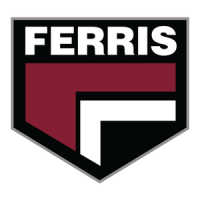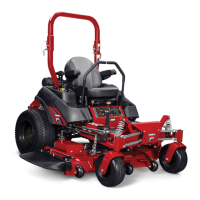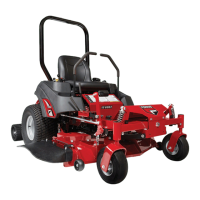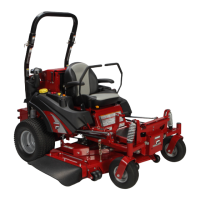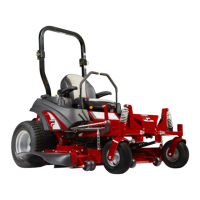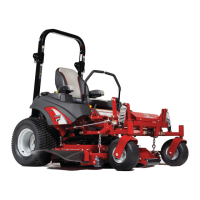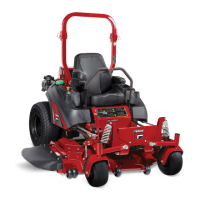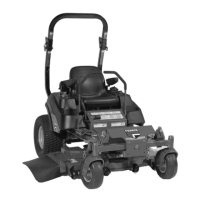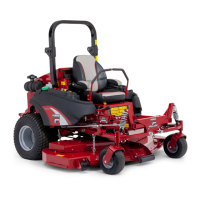10 ferrismowers.com
WARNING
Units with hydraulic pumps, hoses, or motors:Hydraulic
fluid escaping under pressure may have sufficient force to
penetrate skin and cause serious injury. If foreign fluid is
injected into the skin it must be surgically removed within
a few hours by a doctor familiar with this form of injury or
gangrene may result. Keep body and hands away from
pin holes or nozzles that eject hydraulic fluid under high
pressure. Use paper or cardboard, and not hands, to search
for leaks. Make sure all hydraulic fluid connections are tight
and all hydraulic hoses and lines are in good condition
before applying pressure to the system. If leaks occur, have
the unit serviced immediately by your authorized dealer.
WARNING
Stored energy device. Improper release of springs can
result in serious personal injury. Springs should be removed
by an authorized technician.
WARNING
Units equipped with an engine radiator:Stored energy
device. To prevent serious bodily injury from hot coolant or
steam blow-out, never attempt to remove the radiator cap
while the engine is running. Stop the engine and wait until
it is cool. Even then, use extreme care when removing the
cap.
Burn Prevention
Do not touch any part of an operating engine system. The
engine, the exhaust, and the engine aftertreatment system
can reach temperatures as high as 650° C (1202° F) under
normal operating conditions.
Remove all flammable combustible materials or conductive
materials such as fuel, oil, and debris from the engine. Do
not allow any flammable combustible materials or conductive
materials to accumulate on the engine.
Store fuels and lubricants in correctly marked containers
away from unauthorized persons. Store oily rags and any
flammable materials in protective containers. Do not smoke in
areas that are used for storing flammable materials.
Do not expose the engine to any flame.
Engine Maintenance or Repair
Maintenance or repairs to the engine should only be
performed by authorized service personnel.
Roll Bar Instructions
For models equipped with factory-installed Roll Over
Protection System (ROPS).
WARNING
In order to avoid serious injury or death from roll over, it is
important to follow the warnings listed below.
Operational Warnings
• Always use the seat belt when the roll bar is in the raised
position.
• Never use the seat belt when the roll bar is in the down
position.
• Remember there is no roll over protection when the
roll bar is in the down position so it is very important to
always keep the roll bar in the raised position whenever
possible.
• Lower the roll bar to the down position only when it is
absolutely necessary.
• Check for overhead clearances before driving under any
objects. Do not allow roll bar to contact low overhanging
obstacles such as tree branches and guide wires.
• Never remove the roll bar from the vehicle.
• Do not exceed the machine weight rating of the roll bar.
• Read and follow all of the instructions shown below
regarding the inspection and maintenance of the roll bar
structure and the seat belt.
Inspection of the Roll Bar Protective Structure
WARNING
Failure to properly inspect and maintain the ROLL BAR
protective structure can cause serious injury or death.
A ROLL BAR, like any other safety device, needs to be
periodically inspected to verify that the integrity of the device
has not been compromised through normal machine use,
misuse, age degradation, modifications, or a roll over.
To maintain operator roll over protection and roll bar
effectiveness:
• If a ROLL BAR becomes damaged for any reason, such
as a collision, roll over or impact, the ROLL BAR must
be replaced. Small undetectable cracks can reduce the
effectiveness of the ROLL BAR. Never weld, straighten,
or repair the ROLL BAR.
• Never alter the ROLL BAR by welding anything to it or by
drilling additional holes.
• BEFORE FIRST TIME USE - Inspect the ROLL BAR
structure and mounting hardware for:
1) Check to make sure the machine GVW (Gross Vehicle
Weight), including attachments, restrained payload, fuel
and operator, is not in excess of the maximum weight
specified on the ROLL BAR label.
2) Make sure there isn’t any missing, damaged, or loose
mounting hardware.
3) Make sure the ROLL BAR has been correctly and
completely installed.
• EVERY 100 HOURS - Inspect the ROLL BAR structure
and mounting hardware for:
1) Any cracks in the structure (structural members and/or
welds).
2) Significant corrosion on any part of the ROLL BAR
structure or hardware.
3) Missing, damaged, or loose mounting hardware
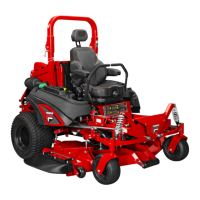
